It is December 5, 1791. Now famous composer Wolfgang Amadeus Mozart dies after a long illness. During this sickbed (and eventually deathbed), Mozart is working on a requiem (music for a specific mass). The last thing Mozart said he wrote before his unfortunate and early death was the Lacrimosa in the sequentia a part of the requiem. The complete requiem and also the biography on Mozart needs to be written, and Mozart’s widow hires the players to help her with these tasks. Will the game end in an ode to Mozart or rather a lament?
Theme and purpose
In the game, the players – each player assumes the role of a financier and patron of Mozart – are given a task by Wolgang’s wife Constanze Mozart (maiden name: Weber). Constanze asks players to tell her about this player’s experience with Mozart for the biography about her husband. At the same time, players will help her hire composers to complete her husband’s last piece of music. Players will reminisce (recall memories about experiences and stories about Mozart), purchase opuses, have them performed and sold, relive Mozart’s travels and work on his final piece of work.
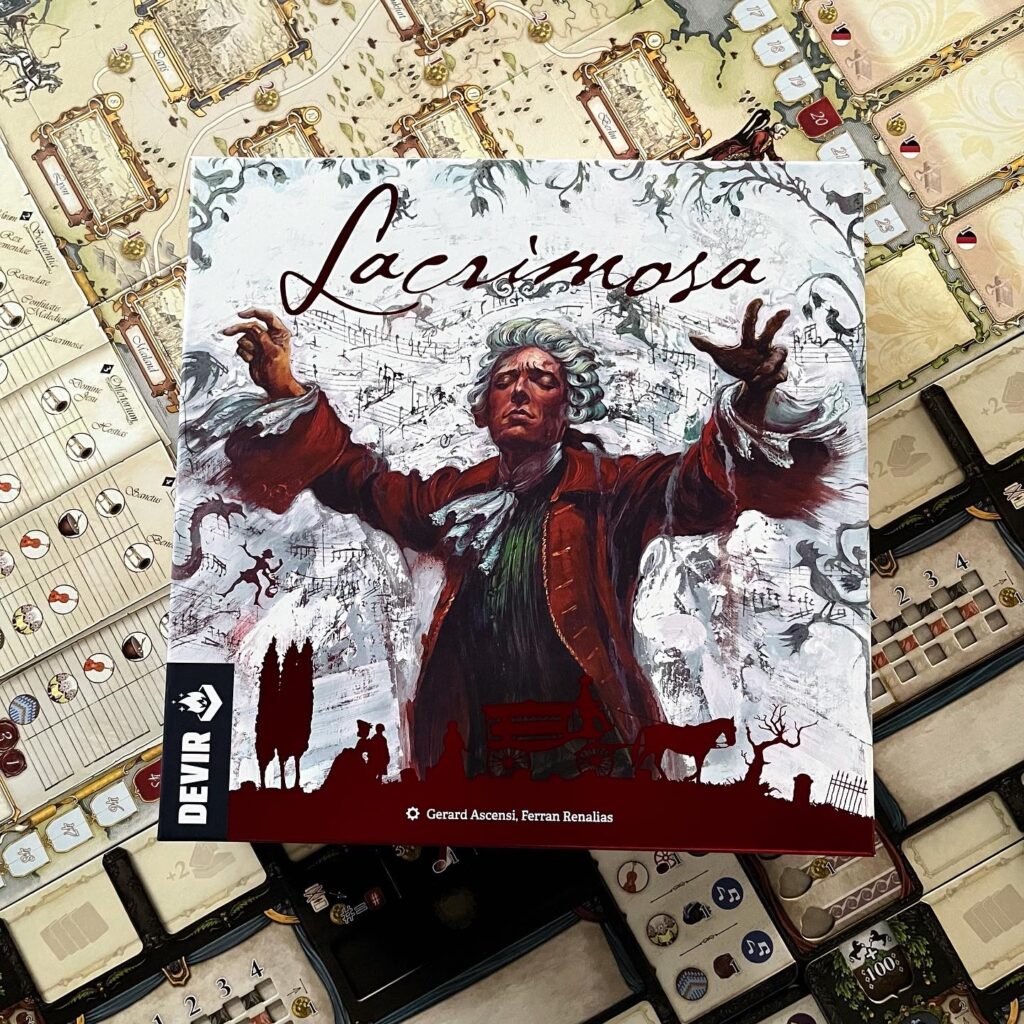
Lacrimosa, the game, is also actually divided into two thematic acts: Mozart’s life (retelling memories of the composer) and the posthumous completion of his requiem. The game board and the various actions players will perform and undertake are therefore linked to these two eras, which interweave smoothly during the game like different movements in a piece of music. The scoring is also largely based on these two acts: in fact, players receive points at the end of the game for the various opuses by Mozart for which they have commissioned and also their contribution to the requiem.
Memories of Mozart
Wolfgang Amadeus Mozart. Composer. Clavierist. Violinist. Conductor. Chocolate Ball. Former child prodigy. Born in Salzburg on Jan. 27, 1756, Mozart was baptized as Joannes Chrysostomus Wolfgangus Theophilus Mozart – though he would later, presumably on his own initiative, start calling himself Wolfgang Amadeus Mozart and become better known under that specific name as well. Mozart’s father, Leopold, was a German composer and music theorist, so Wolfgang was brought up on music. Despite dying at a young age, Mozart enjoyed a relatively long professional career and there are many experiences and stories about Mozart. The experiences and stories are represented in the game by memories (cards) that players can use during the game to perform actions and acquire story points. These story points (Mozart’s talent, travels and compositions) players will use during the game as a kind of currency to perform specific actions.
Mozart’s works
Not only did his father influence Wolfgang’s early musical education, but his older sister Maria Anna “Nannerl” Mozart was also a major influence. When Nannerl was seven, she received her first music lessons while her younger brother (only three years old at that time) looks on with considerable attention. Wolfgang also crawls behind the clavier himself and already hits some sensitive notes in a playful manner. His own music lessons begin when he is four years old, and his father discovers his children’s talent early on. At the beginning of the game, each player receives an opus card with a piece of music in which Mozart had been influenced by his sister. During the game, players can acquire multiple pieces of music, as well as have them performed or even sell them to acquire ducats and other forms of funding.
Hundreds of compositions and works were produced by Mozart. Operas, symphonies, solo pieces and chamber music with different themes and styles. Among other works, Mozart wrote the rondo alla Turka, a march with influences of Turkish music that is part of his 11th piano sonata. With eine kleine nachtmusik, he composed a small serenade for many types of strings. Well-known operas include the cheerful Die Zauberflöte with the mad birdcatcher Papageno who serves as a mold for the “comic relief”: a comical side character for a light-hearted interruption and in contrast he also wrote the melancholic opera Don Giovanni. In the game, the various pieces are divided into religious/spiritual music pieces, symphonies, operas and chamber music, and by putting together certain collections, players can earn points. In total, Mozart probably wrote more than 600 pieces. Despite the many works, Mozart often lived in poverty, in part because of the hole in his hand.
Mozart’s journey
From an early age, Leopold takes his children in tow to different cities to exhibit their musical talents. The game board depicts different cities that Mozart visited during his life. Did you know that Mozart even visited Haarlem in the Netherlands? In 1766, that then ten-year-old Mozart played an hour on the Müller organ in the Grote- or St. Bavokerk. The various cities, and especially royal courts, in the game symbolize various experiences in Mozart’s life and earn points and other bonuses during the game when a player visits these places.
For Mozart we know the further course of his life: a long-running and much-discussed career in music, hundreds of compositions and a mysterious end. When Mozart is five, he can read and write musical notes. At six, he composes his first piece of music. At 35, he dies while working on his requiem. His sister? Nannerl, despite her perhaps equally great talent, had the great disadvantage of being a woman during an even more difficult timeframe. Indeed, in the spirit of the times, she was fit only for marriage, and when she reached an age where she could become engaged, she was no longer allowed to display her talents in public. Perhaps we missed out on a potentially great composer and/or musician .
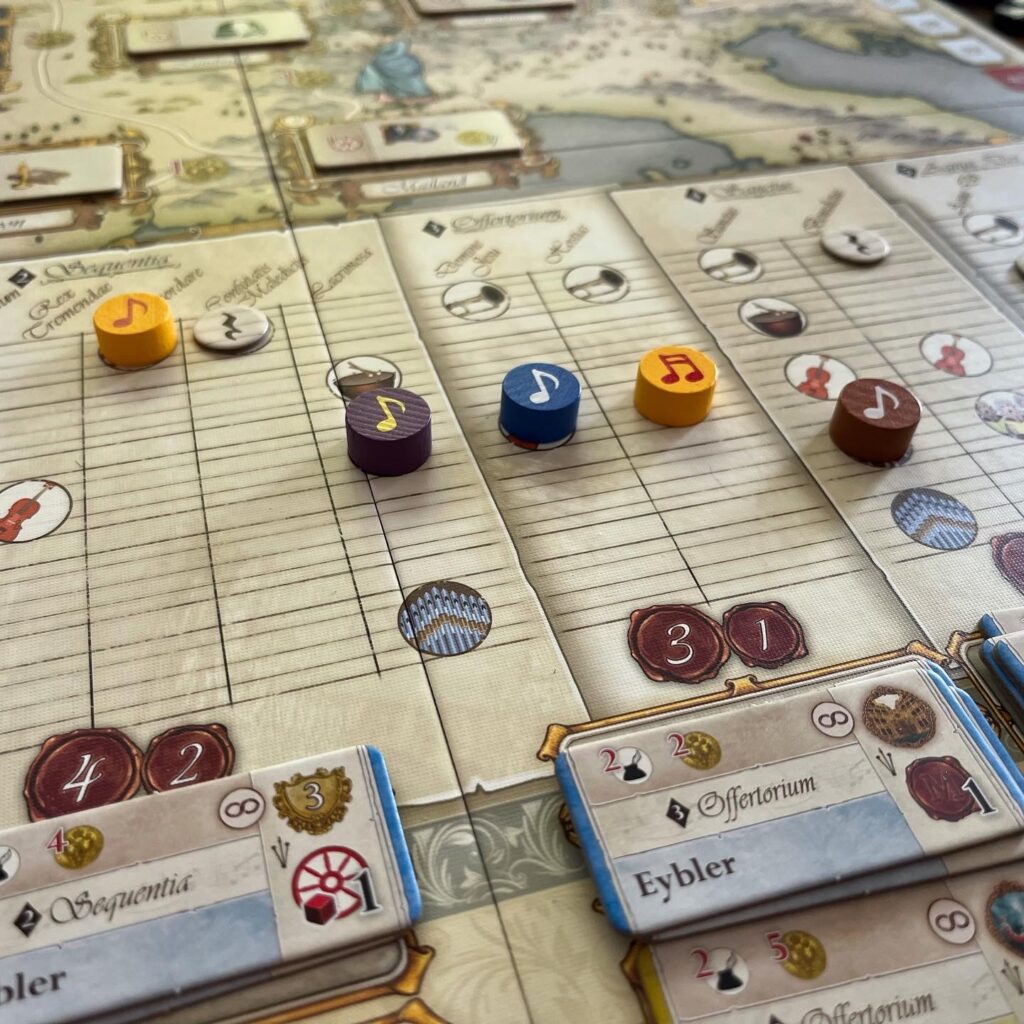

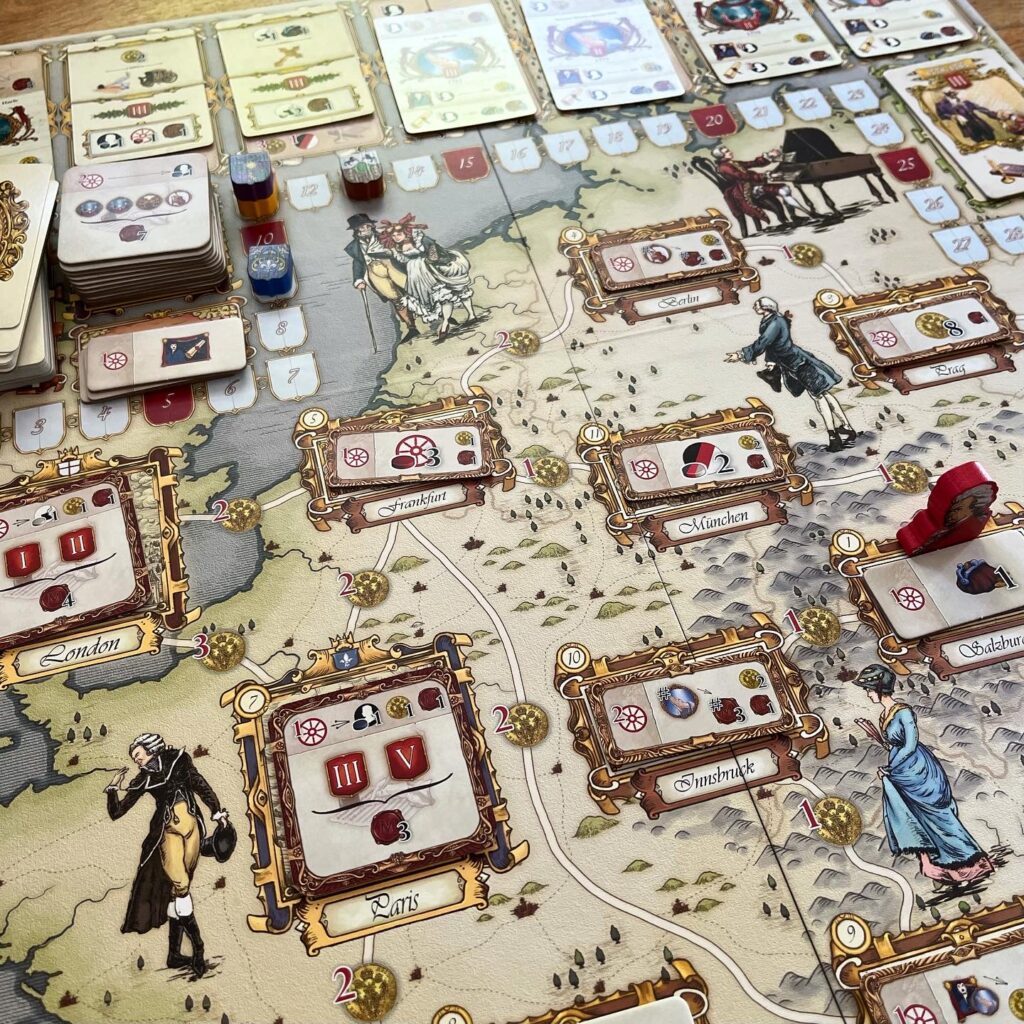
It was December 5, 1791. At the age of 35, Mozart dies. He is busy writing his requiem. The appearance that the piece of music had been completed, despite Mozart’s death, had to be upheld. Constanze, therefore, as in this game, commissioned several composers to finish the work. Initially, Joseph von Eybler is said to have co-written and then Franz Xaver Süssmayr is said to have finished the composition. There are theories that several more composers co-wrote and that Mozart even left detailed instructions to complete the composition. In the game, players are also going to enlist help from different composers (each game only concerns two) who will contribute different parts to the different movements of the requiem. Mozart’s death and also the composition of the requiem are mysterious in nature. The requiem, a piece of music written for a death mass (funeral or memorial), might even have been commissioned through an intermediary. Several plays, biographies and also the film Amadeus have contributed to the creation of these mysteries and plots surrounding Mozart’s death and his last work. There was even a rumor that Mozart may have had the idea that he was writing this piece for his own funeral.
Mozart and games
Mozart had other pastimes besides music. In fact, Mozart himself liked to play games. In the film Amadeus – where the filmmakers applied some creative freedom to the story of Mozart and his relationship with the composer Salieri – Mozart is portrayed as a playful and brash bad boy and plays a variant of billiards/pool. When Mozart visited Milan, he wrote in a letter to home about the card game Mercante he learned while there. He bought the accompanying cards a taught it to others as well. Games and playing them are also referred to in other letters and writings by and about Mozart. Mozart was a (board) player! Not only that: Mozart is even said to have invented a game where you could compose musical pieces with the help of dice. Would that explain the more than 600 compositions? Would Mozart have liked the game Lacrimosa?
Setup
Before players begin conducting their actions, they must first tune their instruments. The game board is placed in the center of the table. The various cards (memories and opuses) are distributed among the five periods and for each period these cards are shuffled. With the cards, in descending order, a draw pile is then formed along with a tile from each period. Cards are turned up for the first period and also matching tiles are placed on the cities and courts on the game board. Players choose two composers to place under the sheet music of the requiem. Each player also receives a player board, several components in their color and a stack of memory cards to start with and an opus card. Players shuffle their memory cards and take 4 in hand.
Gameplay
Lacrimosa is played in five periods, each consisting of four rounds. Each round, each player takes a turn. During a turn, a player plays two cards. One card is played for the action (the experience) and is placed at the top of the player board and the other card is played for story points a player earns at the end of the round (the story). The latter card is placed at the bottom of the player board.
That player’s turn then performs the actions and bonuses on their played experience. Much of the gameplay (or at least the gameplay experience and thematic application of the actions) we have already described above. Indeed, players can as their actions possibly 1. buy new memories, 2. buy opuses, 3. perform or sell opuses, 4. travel through Europe or 5. write to the requiem.
When players buy memories or opuses, they have a choice of the corresponding cards that are on top of the game board. The various cards are placed so that it is clear what kind of cards are involved and what the cost of the card is. Players must pay ducats and relevant story points to purchase cards. Opuses are placed face-up in front of the buyer and purchased memories replace the card that was played as a story this turn, this way a player always has the same amount of memory cards.
When an opus card is performed or sold it produces the indicated bonuses. A performance can be done once per round per card, but a card can only be sold once and a sold card is therefore lost for the rest of the game. Opuses may count for points at the end of the game, so think carefully before you decide to sell.
If a player uses the travel action, that player can move Mozart. You can move Mozart as far as you want, but you must pay the requested toll. By traveling to a city, you can purchase a one-time experience that earns points or other bonuses. By moving to a court, you can earn a tile that allows you to earn points at the end of the game for collected opus cards and contributions to the requiem.
Writing the requiem is perhaps the most extensive element. Each player has several instruments. When a player performs this action, they must place an instrument in the correct spot on the score and indicate with the instrument which composer will be hired. Players pay the cost of the composer and receive a tile that may also bring back (ongoing) bonuses. At the end of the game, each movement is examined to see which composer contributed the most and players receive points based on their support of these composers. The more popular composer earns more points, but also becomes more expensive each time, so players must carefully decide which composer to hire.

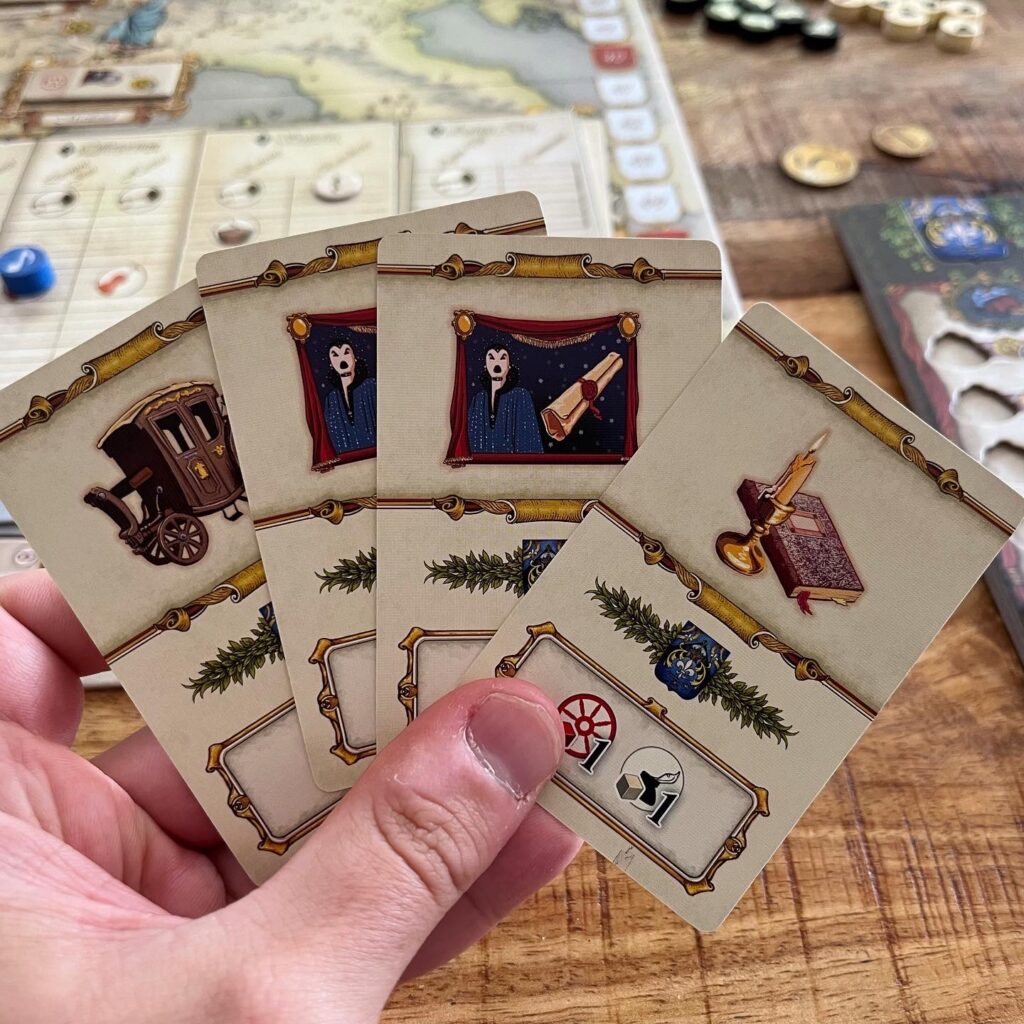
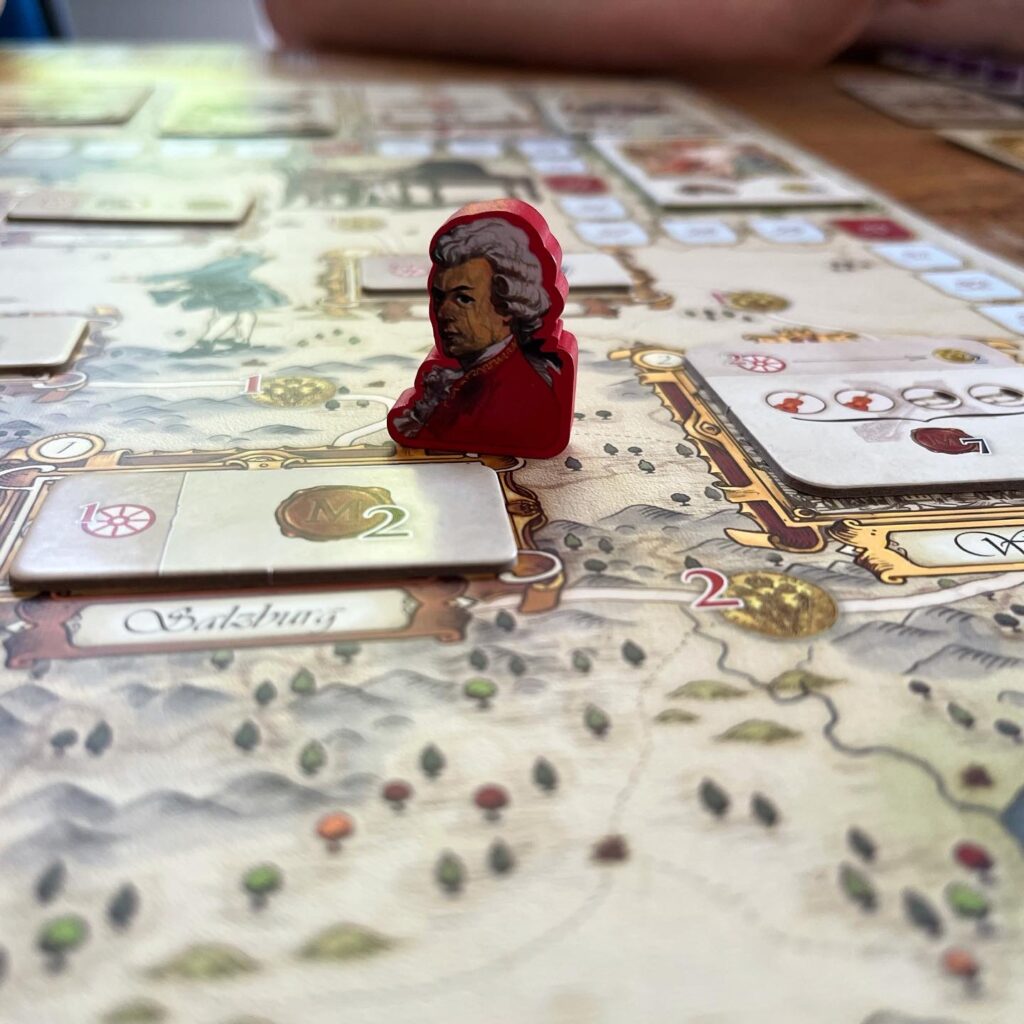
At the end of a round, all unused story points on the player board expire and players receive new story points, points and bonuses based on the cards played and their funding level. They take back all cards and shuffle them. The cards and tile for a new time period is placed on the board, tiles from cities and courts may be turned over, and players are ready for the next round.
Verdict
Lacrimosa is a great thematic and strategic game. It is definitely not a cacophony of different game elements cobbled together to which the Mozart theme is pasted. The game is elegant and intuitive and has a delightful and clear game play that is prompted by the theme. The theme splashes off the game and you can tell that the creators of the game have done their homework. By the way, the game is mostly inspired by Mozart’s life and less by music theory.
The game play is clear, but the game is complex because of its strategic component. So the game is complex not because of a large amount of rules, but because of the wide variety of different choices and freedom of players. Each turn, players face a choice: which memory do I play as an experience and which as a story? A simple act with many potential outcomes.
The game’s scoring feels tight and uncluttered, providing a clear balance between players and different actions. As players collectively move Mozart around the board, choose from a shared market of cards and collectively hire composers to influence the scoring, Lacrimosa is also highly interactive in a semi-indirect way.
Do you want to play a strategic game with strong and distinctive theme and interesting gameplay? Then join us in writing the requiem and imagine yourself a true Mozart!




